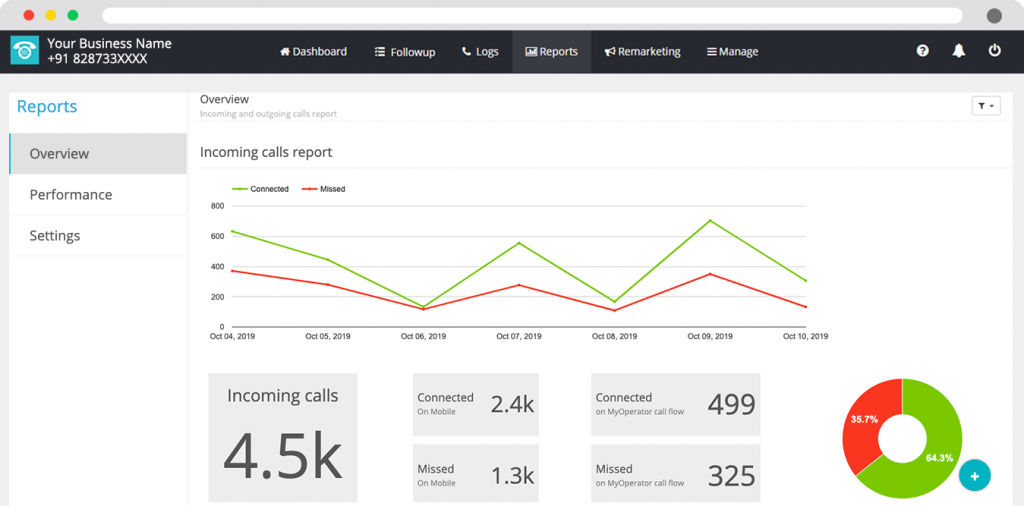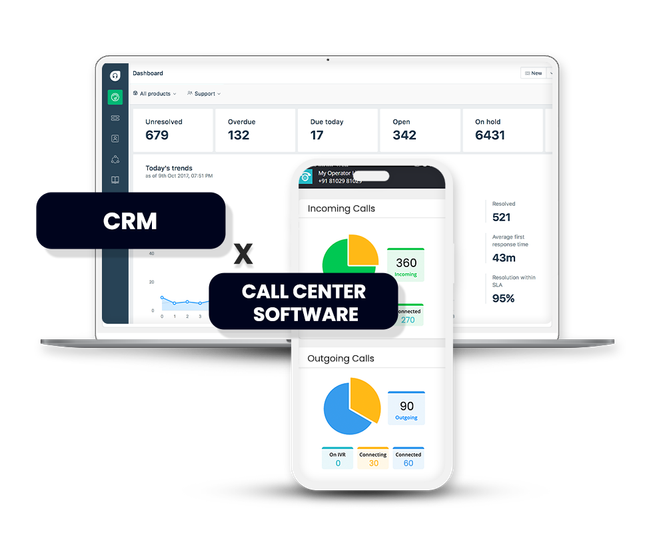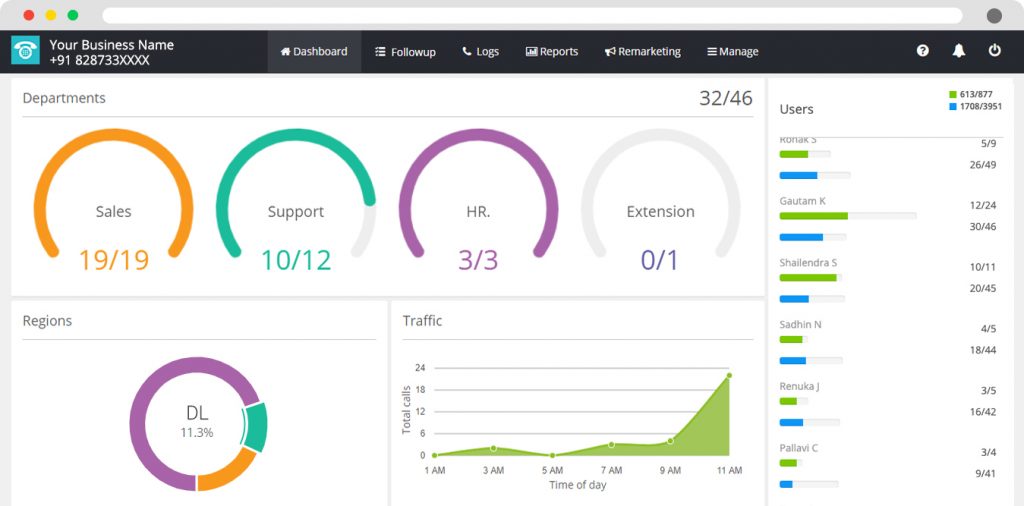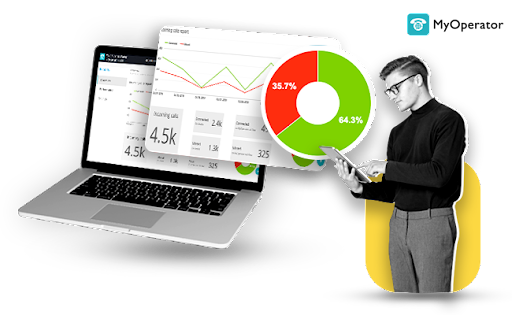With the advent of AI, businesses are now leveraging AI-powered customer service analytics to gain valuable insights into customer interactions, preferences, and pain points.
Data is the new oil that fuels businesses to progress continuously. With Customer Service Analytics data-driven approach, companies can enhance their customer service strategies, optimize processes, and ultimately improve customer satisfaction.
In this article, we will delve into the world of AI-driven Customer Service Analytics, explore its best use cases, and provide examples of how MyOperator products in conjunction with CRM syncs can revolutionize customer service.
Understanding Customer Service Analytics
At its core, customer service analytics is the practice of collecting, analyzing, and interpreting customer data to gain actionable insights.
Such an AI-powered approach is particularly impactful in the realm of cloud contact center services, such as MyOperator.
It spans a wide array of metrics, including customer feedback, interaction history, response times, and channel preferences.
By meticulously scrutinizing these datasets, businesses, including those utilizing cloud contact center services, can gain a comprehensive understanding of customer behavior, preferences, and patterns, enabling them to fine-tune their customer service strategies.
This process is further simplified by MyOperator’s user-friendly, no-code platform, ensuring that even individuals with zero technical knowledge can monitor and leverage these insights to drive businesses forward.
Significance of AI-powered Customer Service Analytics
The significance of customer service analytics cannot be overstated. It offers several key benefits that can have a transformative impact on a company’s customer support efforts:
1. Data-Driven Decision Making
AI-powered Customer service analytics provides an evidence-based foundation for decision making. Instead of relying on assumptions, businesses can make informed choices backed by real customer data.
Customer service analytics can help streamline response processes.
For instance, by analyzing historical data, a company using MyOperator products could identify peak hours of customer inquiries. Similarly, the integration of AI in telecom can revolutionize customer service analytics, offering advanced insights and predictive capabilities to enhance customer interactions and operational efficiency.
This information allows them to allocate resources effectively, ensuring that customer queries are addressed promptly.
2. Enhanced Customer Experience
By understanding customer preferences and pain points, companies can tailor their support interactions, resulting in personalized experiences that foster customer loyalty and satisfaction.
Analyzing customer interactions can provide insights into individual preferences.
If a customer frequently inquires about a specific product, a business can tailor their interactions to offer personalized recommendations. This level of personalization can boost customer satisfaction and loyalty.
3. Proactive Issue Resolution
Through pattern recognition, customer service analytics enables companies to identify potential issues before they escalate, allowing for swift proactive measures.
Al-powered customer service analytics can enable proactive issue resolution.
If multiple customers are contacting support about the same problem, the company can identify the issue quickly and address it before more customers are affected. This demonstrates a proactive approach to problem-solving.
4. Identifying Bottlenecks
By tracking and analyzing the stages of customer inquiries, businesses can identify bottlenecks in their support processes.
For example, if there’s a delay in transferring calls from an IVR system (Interactive Voice Response) to a live agent, this data can highlight the need for process optimization.
5. Optimizing Channel Usage
Different customers prefer different communication channels.
Analytics can help businesses understand which channels are most popular among their customer base. For instance, if a majority of customers prefer live chat, the company can allocate more resources to this channel for faster response times.
6. Resource Allocation
With insights into peak support hours and popular communication channels, businesses can allocate resources more effectively, ensuring optimal coverage during busy periods.
7. Continuous Improvement
Regular analysis of customer service data enables a continuous improvement cycle. Companies can identify areas for enhancement, implement changes, and measure the impact of those changes over time.
AI-Powered Customer Service Analytics – Methodologies and Techniques

Customer service analytics employs various methodologies and techniques to extract meaningful insights from data. Some of these include:
Text and Sentiment Analysis
By analyzing customer feedback, whether through emails, chat transcripts, or social media, businesses can gauge sentiment and identify common issues or concerns.
Call Volume Analysis
For companies with high call volumes, tracking peak hours and call patterns can aid in staffing decisions, ensuring sufficient coverage during busy times.
Customer Journey Mapping
Mapping out the entire customer journey, from initial contact to resolution, can uncover pain points and areas where the experience could be improved.
Channel Preference Analysis
Understanding which communication channels customers prefer—such as phone, email, chat, or social media—enables businesses to allocate resources appropriately.
Root Cause Analysis
When issues arise, delving into the root causes through data analysis can help prevent similar issues in the future.
AI-Powered Customer Service Analytics: Real World Applications

Customer service analytics is a cross-industry phenomenon that empowers businesses to offer superior customer experiences, streamline operations, and identify areas for improvement.
By harnessing the power of data-driven insights, companies across various sectors can tailor their services, optimize processes, and build lasting customer relationships.
As industries continue to evolve, the role of customer service analytics will remain pivotal in ensuring customer satisfaction, loyalty, and business success
Here are the Real-World Applications of Customer Service Analytics Across Industries
1. Retail and E-Commerce
Scenario: An e-commerce platform analyzes customer browsing and purchase history. By applying analytics, they can recommend personalized products and send targeted promotions, enhancing the shopping experience.
b In the retail and e-commerce sector, customer service analytics helps companies understand individual shopping preferences.
By analyzing past purchases, browsing behavior, and wish list items, businesses can offer personalized product recommendations. This tailored approach not only increases the likelihood of conversions but also fosters customer loyalty.
2. Telecommunications
Scenario: A telecommunications company examines call data to identify areas of high call volume. This information allows them to offer self-service options for common inquiries, reducing call volume and wait times.
Application: In the telecommunications industry, customer service analytics aids in managing the high volume of customer inquiries.
By analyzing call patterns and identifying frequently asked questions, companies can develop comprehensive self-service options, such as interactive FAQs or automated troubleshooting guides.
This empowers customers to find solutions on their own, reducing the strain on customer support and improving overall customer satisfaction.
3. Hospitality and Travel: Scenario
Scenario: A hotel chain analyzes customer feedback across various platforms. By identifying recurring complaints about slow check-in processes, they implement changes that streamline the check-in experience.
Application: The hospitality and travel sector benefits from customer service analytics by optimizing guest experiences.
Analyzing customer feedback from online reviews, surveys, and social media platforms can uncover pain points in the customer journey.
In this case, addressing a slow check-in process through data-driven improvements enhances guest satisfaction and reviews, ultimately attracting more patrons.
4. Software and Technology
Scenario: A software company tracks support tickets and categorizes them by issue type. They notice a trend of customers struggling with a specific feature, prompting them to release a comprehensive tutorial and reduce related support inquiries.
Application: For software and technology companies, customer service analytics can streamline support efforts.
By categorizing support tickets and analyzing trends, businesses can identify areas where customers face challenges.
Offering resources such as detailed tutorials or video guides for commonly misunderstood features not only reduces support inquiries but also empowers users to maximize the software’s capabilities.
5. Healthcare and Medical Services
Scenario: A healthcare provider analyzes patient feedback to identify common complaints about appointment scheduling. By leveraging analytics, they optimize their scheduling system for greater efficiency.
Application: In the healthcare sector, customer service analytics contributes to patient satisfaction.
By analyzing patient feedback and complaints, healthcare providers can identify pain points in processes like appointment scheduling, billing, or prescription refills.
This data-driven approach allows providers to refine their operations, leading to smoother patient experiences and improved patient outcomes.
6. Financial Services
Scenario: A bank analyzes customer interactions across different channels and notices a high volume of inquiries related to account balances. They enhance their mobile app’s real-time balance display to address this issue.
Application: In the financial services industry, customer service analytics aids in optimizing service delivery.
By tracking customer interactions across channels like phone, chat, and mobile apps, banks can pinpoint areas of high demand.
In this example, improving the mobile app’s real-time balance display addresses a common customer inquiry, reducing the need for direct support and providing a more seamless banking experience.
Examples of Customer Service Analytics with MyOperator Products and CRM Syncs

Customer service analytics, when combined with MyOperator’s innovative products and integrated with CRM systemsbenefits of CRM, opens a realm of possibilities for businesses to enhance their customer support strategies.
Even individuals with no technical background can easily navigate MyOperator’s user-friendly, no-code platform, gaining a comprehensive understanding of its features to drive businesses in various sectors
From small scale business to large enterprises, the benefits of CRM integration sprawls across boundaries.
Let’s delve into detailed explanations of the examples provided
1. Call Volume Optimization
MyOperator’s call management solutions offer a unique opportunity to optimize call volumes with CRM integration.
Consider a hotel chain as an example. By analyzing call data, they can identify patterns of peak call hours.
Suppose most reservation calls flood in during the evening. Through CRM synchronization, the hotel can strategically schedule more staff during these high-demand periods.
This proactive approach ensures that customers experience shorter wait times and more efficient service, ultimately leading to improved customer satisfaction.
2. Personalized IVR Routing
MyOperator’s Interactive Voice Response IVR solution takes on a new dimension when integrated with CRM data.
Imagine a bank leveraging this integration to enhance customer experiences. By examining customer history and profiling, they can direct high-net-worth clients to specialized agents directly through the IVR menu.
This personalized routing not only streamlines the support process but also communicates the bank’s recognition of the customers’ value and specific needs, fostering a deeper sense of loyalty and engagement.
3. Customer Feedback Analysis
MyOperator’s call recording and transcription features, combined with CRM synchronization, prove invaluable for understanding customer feedback nuances.
For instance, if multiple customers consistently mention challenges with a particular product feature during interactions, the company can swiftly identify the recurring issue.
The integration of call recordings and transcriptions with CRM data enables them to prioritize addressing this concern promptly.
By demonstrating a proactive attitude towards resolving customer pain points, the company reinforces its commitment to customer satisfaction and continuous improvement.
4. Omnichannel Integration
MyOperator’s integration capabilities extend beyond single-channel interactions. In the context of CRM syncs, this manifests as a seamless omnichannel experience.
Suppose a customer initiates an inquiry through live chat and later follows up with a phone call.
Thanks to the integration between MyOperator and the CRM system, the support agent can access the entire chat history during the call.
This continuity eliminates the need for customers to repeat information, delivering a cohesive experience that underlines the company’s dedication to a customer-centric approach.
5. Customer Journey Analysis
MyOperator’s integration with CRM systems allows businesses to analyze the complete customer journey.
For instance, consider an online retail store. By mapping customer interactions from the initial website visit to the final purchase, companies can pinpoint critical touchpoints and potential drop-offs.
This data-driven insight enables them to optimize the user experience, ensuring a smooth and engaging journey that encourages conversions.
Moreover, identifying common drop-off points empowers businesses to implement targeted strategies for customer retention and re-engagement.
6. Service Quality Benchmarking
MyOperator’s call recording and CRM integration can serve as a powerful tool for benchmarking service quality.
Imagine a contact center for a telecom company. By systematically recording and analyzing calls, they can establish quality standards based on factors like call duration, issue resolution time, and customer feedback.
These benchmarks can then be compared against actual performance. If there’s a deviation, immediate corrective measures can be taken, ensuring consistent and high-quality customer interactions.
7. Trend Identification and Proactive Support
MyOperator’s analytics can be leveraged to identify emerging trends and facilitate proactive support. Take an insurance company as an example.
By analyzing call data, they might notice an increasing number of inquiries related to a particular policy clause.
Recognizing this trend early on, the company can create informative content addressing the concerns and distribute it through various channels, such as email newsletters or SMS notifications.
This proactive approach not only alleviates potential customer frustrations but also showcases the company’s dedication to keeping its clients well-informed.
8. Social Media Engagement Insights
MyOperator’s integration with CRM systems can extend to social media interactions. Consider a consumer electronics brand monitoring their social media channels.
By syncing social media data with the CRM, they can track customer interactions, sentiment, and inquiries across platforms.
This comprehensive view enables them to respond promptly to customer inquiries, address negative sentiment, and even identify opportunities for product improvements based on feedback shared on social media platforms.
MyOperator’s Customer Service Analytics: Best Use Cases

The MyOperator product dashboard stands as a beacon of customer service analytics, offering a multifaceted toolkit that caters to the unique needs of various industries.
Each function within the dashboard acts as a strategic lever, empowering businesses to optimize their customer service strategies. Let’s explore how different industries can utilize these functions
1. Call Volume Optimization
Function: This function provides insights into call volume trends, helping businesses understand peak call hours and customer engagement patterns. Applications Across Industries:
Retail: Retailers can anticipate high call volumes during sales and promotions, allowing them to allocate additional staff to handle inquiries swiftly.
Healthcare: Hospitals can analyze call spikes during specific times, optimizing staff scheduling for appointment bookings and patient queries.
E-Commerce: During product launches or flash sales, e-commerce platforms can prepare for increased call traffic by deploying additional support agents.
2. Agent Performance Analysis
Function: Agent performance metrics, such as response times, call resolutions, and customer feedback, are available for evaluation. Applications Across Industries:
Telecommunications: Telecom companies can track agent efficiency in resolving technical issues, reducing call durations and improving customer satisfaction.
Hospitality: Hotels can monitor front-desk staff performance to ensure efficient check-in processes and seamless guest experiences.
Financial Services: Banks can analyze agent response times to enhance query resolution speed for account-related inquiries.
3. Customer Demographics Insights
Function: This feature provides demographic data about customers, including geographical distribution and preferences. Applications Across Industries:
E-Commerce: Online retailers can tailor product recommendations based on geographic preferences and cultural trends.
Travel: Airlines can customize their marketing campaigns by understanding the regions with the highest customer engagement.
Education: Educational institutions can analyze the geographic origin of inquiries for admission-related information.
4. Personalized IVR Routing
Function: MyOperator’s IVR system integrated with CRM data enables personalized routing of calls to specialized agents. Applications Across Industries:
Banking: High-net-worth customers can be routed directly to relationship managers, providing tailored financial solutions.
Healthcare: Patients with specific medical needs can be directed to specialized departments or doctors for personalized care.
Insurance: Complex policy inquiries can be directed to experienced agents, improving the accuracy and relevance of responses.

5. Customer Feedback Analysis
Function: Call recording and transcription features synced with CRM data facilitate in-depth analysis of customer feedback. Applications Across Industries:
Information Technology: Software companies can swiftly address software bugs or user difficulties based on customer feedback insights.
Hospitality: Hotels can improve guest experiences by identifying and addressing recurring concerns from guest feedback.Retail: Retailers can modify product offerings based on customer complaints or suggestions, enhancing customer satisfaction.
6. Omnichannel Integration
Function: MyOperator’s integration with CRM systems allows for seamless communication across channels. Applications Across Industries:
E-Commerce: Customer interactions initiated via email, chat, or phone can be seamlessly continued across channels, improving resolution efficiency.
Insurance: Clients can switch from email inquiries to phone conversations without repeating information, streamlining the claims process.
Healthcare: Patients can seamlessly transition from scheduling appointments online to confirming details over the phone, ensuring data consistency.
Conclusion
Customer service analytics is a versatile tool that can be applied across various industries and sectors.
From call volume optimization and agent performance analysis to customer demographics insights and personalized routing, each CSA function contributes to enhancing customer experiences, streamlining processes, and driving growth.
By harnessing the power of these functions, businesses can transform raw data into actionable insights that guide strategic decisions, foster customer loyalty, and create a competitive advantage in today’s dynamic business landscape.
It’s a powerful tool for understanding customer behavior, optimizing processes, and fostering strong customer relationships.
MyOperator’s Customer Service analytics provide businesses with actionable insights to enhance their customer support strategies, improve customer satisfaction, and drive operational efficiency.
By utilizing these functions, businesses can leverage data-driven insights to optimize customer experiences, streamline operations, and drive growth.
From retail and healthcare to technology and hospitality, each sector can harness the power of MyOperator’s Cloud Contact Center service analytics to create a customer-centric approach that fosters loyalty, engagement, and excellence in customer service.


